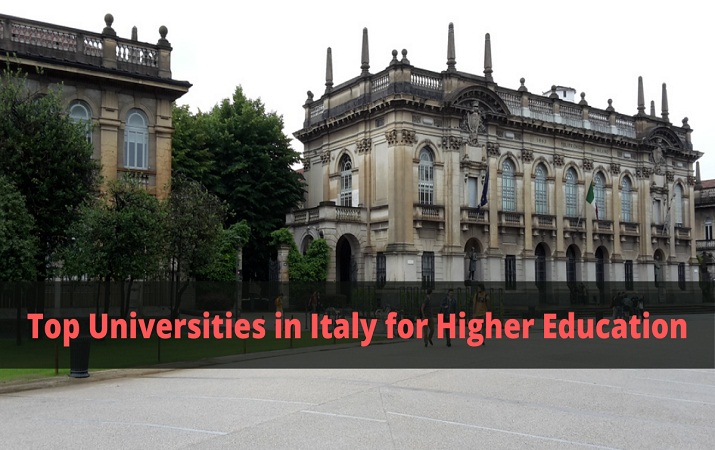Students choice of selecting a university abroad depends heavily on the employability opportunities. Every year “The Times Higher Education” releases ranking list for universities around the world. The ranking is based on 13 performance indicators which measure the institution’s performance across teaching, research, knowledge transfer and international outlook.
The list is prepared after compiling answers of several recruiters, chief executives and business managers from top companies in 20 countries.
Let us have a look at the list “Top 10 Universities in Italy for Higher Education for the year 2020”
Sant’Anna School of Advanced Studies – Pisa
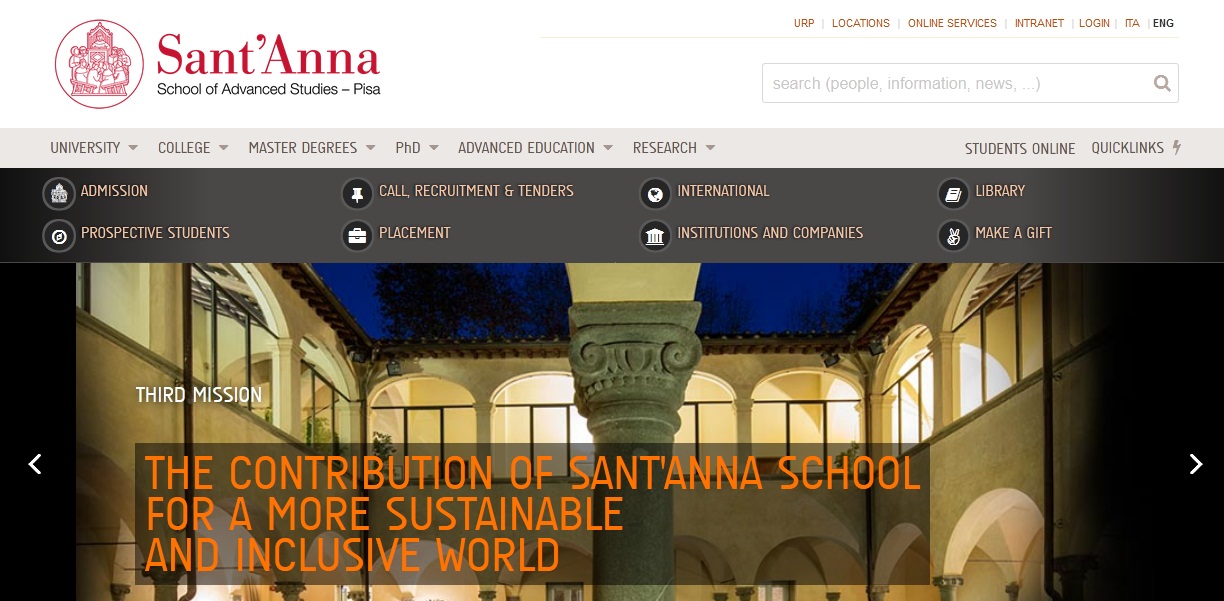
The Sant’Anna School of Advanced Studies, or Scuola Superiore Sant’Anna de Pisa to give its full Italian name, is a public university specialising in applied sciences.
Established in 1987, Scuola Superiore Sant’Anna is ranked in the top ten of the Times Higher Education’s 150 Under 50, celebrating young, successful universities.
Scuola Superiore Sant’Anna is a university with the accreditation to award its own master’s and PhDs, but its undergraduate degrees are awarded in partnership with the University of Pisa. Students at the University of Pisa sit rigorous exams for entrance to Scuola Superiore Sant’Anna’s programme.
Students are required to achieve top marks in entrance exams and demonstrate proficiency in two foreign languages. In return, they can study at Scuola Superiore Sant’Anna for free.
The fields of study at Scuola Superiore Sant’Anna are Business Sciences, Economic Sciences, Legal Sciences, Political Sciences, Agricultural Sciences, Medical Sciences, Industrial Engineering and Information Engineering.
Scuola Superiore Sant’Anna has produced some of Italy’s most prominent political and scientific minds. Italian Prime Minister Giuliano Amato, neuroscientist Giuliano Tononi and economist Nicoletta Batini are just a few of the school’s most influential alumni.
Students at Scuola Superiore Sant’Anna get to study in Pisa, a historic town with dozens of landmarks, churches and points of interests besides its famous leaning tower. The surrounding Tuscany region is famed for its natural beauty, vineyards, beaches, and the stunning architecture of the capital city, Florence.
Scuola Normale Superiore di Pisa
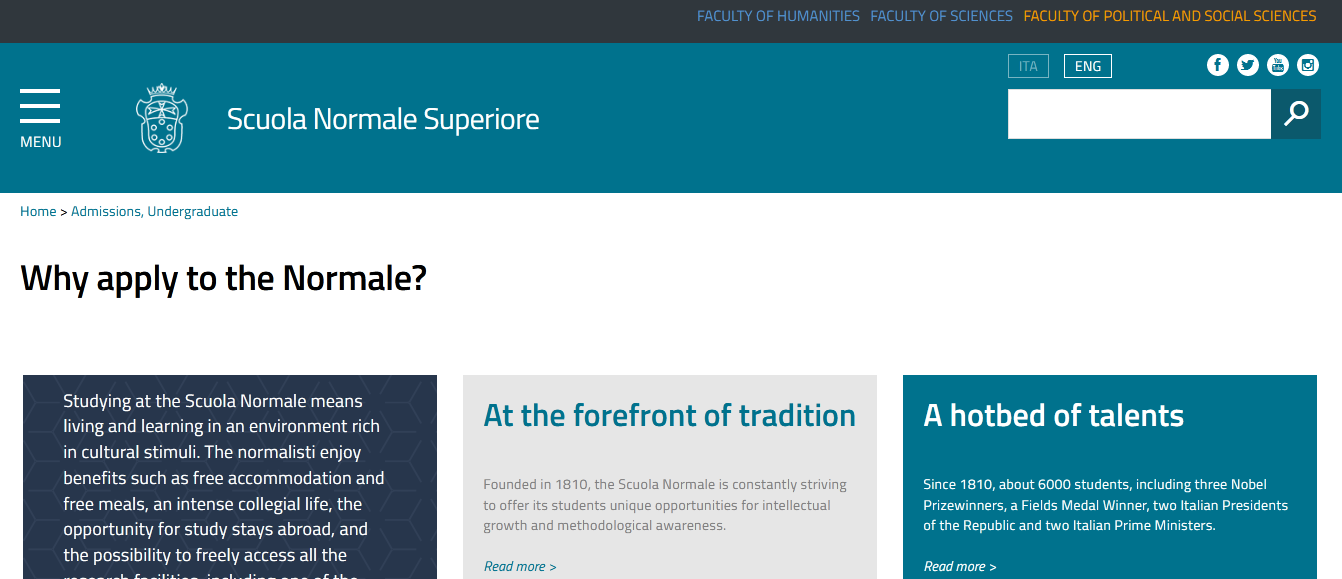
The Scuola Normale Superiore di Pisa is a public institute for higher education with unique features: student selection exclusively based on merit, lessons on a seminar basis, deeply intertwined teaching and research, an integrated college life and the encouragement of international exchanges based on the best European model of higher education. In Pisa, lecturers, researchers and students inhabit the same spaces, with teaching and laboratory activities, cultural events and experimental initiatives all taking place in a single area. Two types of course are available: the undergraduate course and the PhD course. The teaching activity is distributed among three academic structures: the Faculty of Humanities, the Faculty of Mathematical and Natural Sciences and, for the PhD course only, the Institute of Humanities and Social Sciences, situated in Palazzo Strozzi in Florence. The great resource of the Scuola Normale is the quality of its students. Selected on the basis of merit through a special examination, they live in a completely free college system and follow a course of studies revolving around a natural mix of experience, research, in-depth study and moments of intuition.
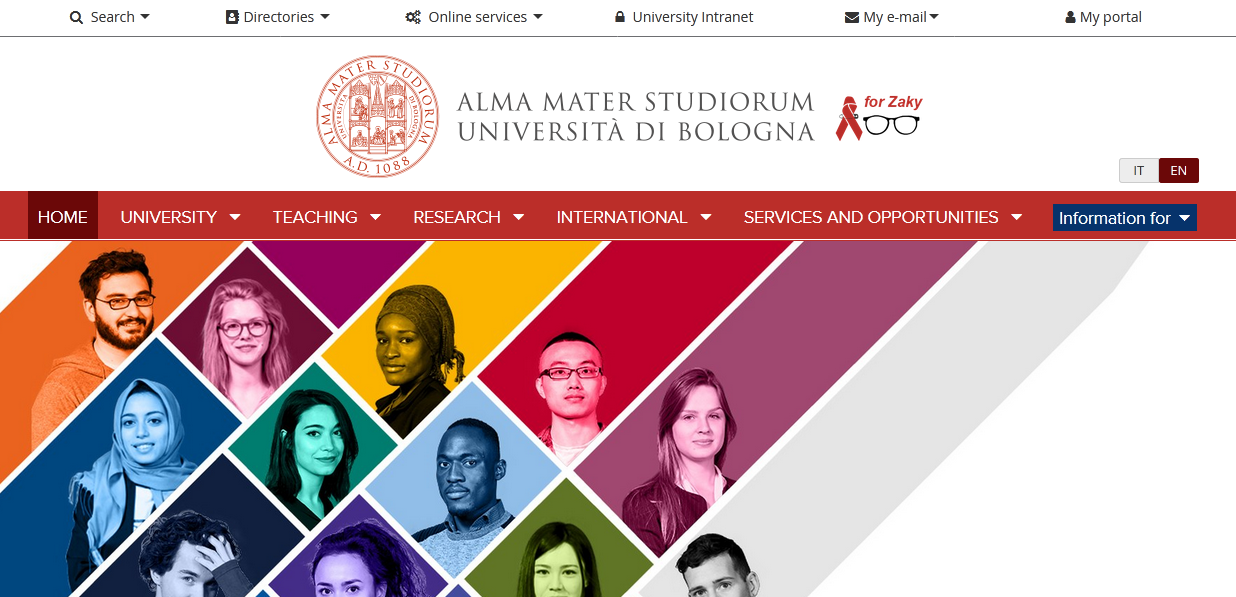
Founded in 1088, Bologna University is the oldest university in the world and it has been student-centred whilst attracting prominent figures from science and the arts. Today it is a leader in the European Higher Education Area and famous for its beauty and integration with the city. Its teaching catalogue is diversified and tailored to the needs of present-day society: 221 degree programmes of which 78 international and 62 taught in English, 33 Departments and over 87,000 students. A further 4.000 are candidates for its PhDs and 3rd cycle programmes. The calibre of its graduates, its internationally renowned teachers and its quality research give it a competitive edge, especially in the job market.
The University of Bologna has a Multicampus structure, with campuses in Bologna and the Romagna region – Cesena, Forlì, Ravenna and Rimini, and permanent headquarter in Buenos Aires since 1998 coordinating research, post-graduate training and academic liaison with Latin America. Beyond its close European links Bologna enjoys multiple international connections, with North America, Africa, Asia and Australia.
With regard to the international reputation, the University of Bologna is among the top 5 Italian universities in the main International rankings. It aims for excellence both in the education and in research. It has been successfully evaluated and thus funded by the Italian Ministry of Education for excellent research activities within its Departments. It is the second Italian University in terms of funds received by the European Commission under the Research and Innovation Programme Horizon2020. The Alma Mater ranks among the top universities in Europe for funding for competitive research.
The University of Bologna is committed to the values of sustainability, such as enhancing and safeguarding the territory, improving community wellbeing, promoting a knowledge-based development economy, social equity, and the ability of those involved to work effectively together for the common good.
Why the University of Bologna?
Because you can start now to become what you want to be You can choose from 220 degree programmes, including 78 international programmes and 62 delivered in the English. And after graduation? There are lots of opportunities to specialize and come into contact with the world of work.
Because it is the oldest and the newest university
The origins of the University of Bologna go way back, and it is considered to be the oldest university in the Western world. Its history is intertwined with that of the great names of science and literature; it is a keystone and a point of reference for European culture.
Because it provides highest level training and rewards merit
Study grants, fee exemptions, housing and meal discounts, 150-hour collaboration contracts, tutorships are just some of the opportunities available to deserving students or those needed economic support.
Because it is your passport to the world
Alma Mater, thanks to its international vocation, is related with the most important universities in the world, in a continuous exchange of students and teachers. An experience studying or working abroad is the best way to understand the world and pay new ways for your future.
The Alma Mater holds first place among Italian Universities in terms of the number of students abroad and the quantity of funding received under Erasmus+ and is among the top 5 universities in Europe in terms of number of exchange students.
Because it helps you to imagine a better world and work to contribute to it
Projects, initiatives and research facilities for developing new ideas, innovation and knowledge for facing global challenges.
Because it gives you space for your passions
Not just studying at UNIBO: language courses, university events, music, sport and plenty more to enrich your university experience
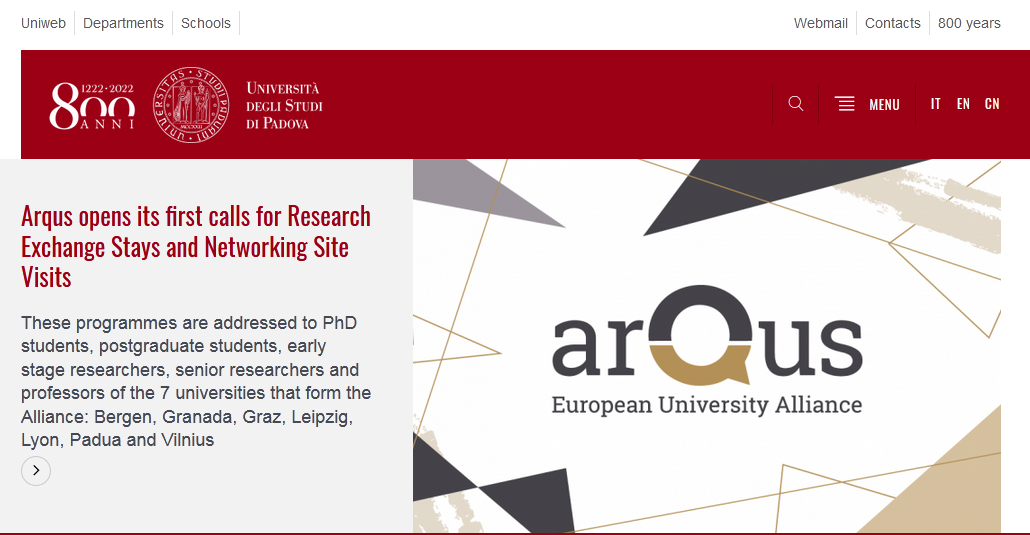
Established in 1222, the University of Padua (Padova in Italian) is the second oldest university in Italy, after Bologna, and one of the earliest universities in the world. It was originally founded as a school of law by a group of scholars and students who had come from Bologna in pursuit of greater academic freedom.
Today, Padua continues to be one of the most prominent universities in Italy and Europe. It is made up of 32 departments and eight schools, which co-ordinate the courses managed by each department, as well as 49 specialisation schools and 43 research and service centres.
Comprising Schools of Agricultural Sciences and Veterinary Medicine, Economics and Political Science, Law, Engineering, Medicine, Psychology, Science, and Human and Social Sciences and Cultural Heritage, Padua also runs a host of centres, research organisations and science and technology hubs that are affiliated with the university. Its estate is also home to a university hospital, one museum, a library, a school of excellence and 14 halls of residence.
Around 60,000 students – 40,000 undergraduates and 20,000 postgraduates – are enrolled at Padua. They share the university’s medieval buildings with more than 20,000 professors and research staff, as well as a commitment to the continuation of Padua’s longstanding tradition of academic innovation.
The university’s total budget is over €600 million with around €60 million a year spent on research.
Padua is part a network of historical research universities known as the Coimbra Group. Other institutions that are part of this network include the universities of Oxford, Cambridge, Heidelberg, Salamanca, Jena, Leuven and Leiden.
Vita-Salute San Raffaele University
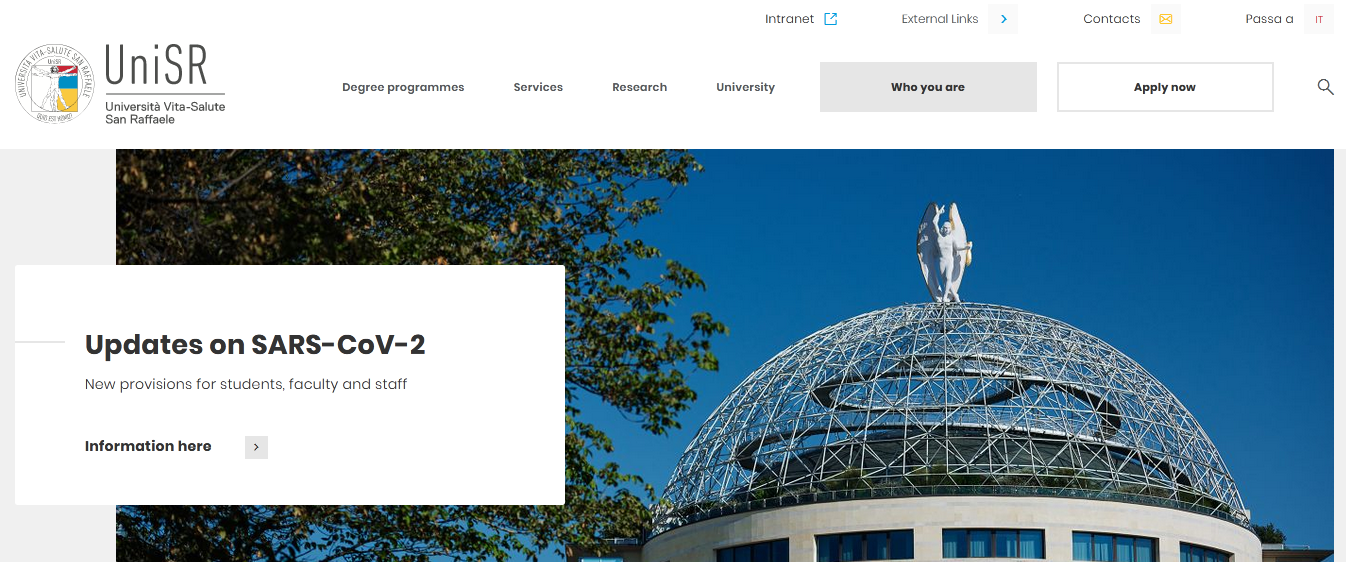
The Vita-Salute San Raffaele University (UniSR), a private university in Milan, started with just a department of psychology in 1996. Today it has Faculties of Medicine and Surgery, Psychology, and Philosophy, all following cognitive and experimental lines of thought. As such, the courses tend to have an interdisciplinary emphasis.
Affiliated with the nearby San Raffaele Hospital (OSR), UniSR offers undergraduate degrees in Philosophy, Medical and Pharmaceutical Biotechnology, Physiotherapy, Nursing, Dental Hygiene, and Psychological sciences and techniques, as well as Masters courses in Dentistry and Dental Implantology, Molecular and Cellular Medical Biotechnology, Medicine and Surgery, and Psychology.
In 2010 an English language medical course was started with an innovative curriculum designed to foster doctors with the human, cultural and professional values. Half of the places are reserved for EU citizens and half for non-EU citizens. There are also PhD courses in Philosophy and Molecular Medicine, and an English language PhD in Cognitive Psychology in Health Communication.
The Library of Philosophy is comprised of classical philosophical texts, mostly in the original language, and subscriptions to more than 50 philosophy journals in electronic and printed form. Count Andrea Emo has donated his private library on literary and philsophical subjects, including many first editions of the major italian philosophers of the 19th century. The Reale Fund, donated by Professor of History of Ancient Philosophy Giovanni Reale, comprises 2,300 original philosophical works and critical studies on ancient philosophy and early Christian writers. The Biomedical library originated as the San Raffaele Library at the end of the 1970s, as part of the OSR.
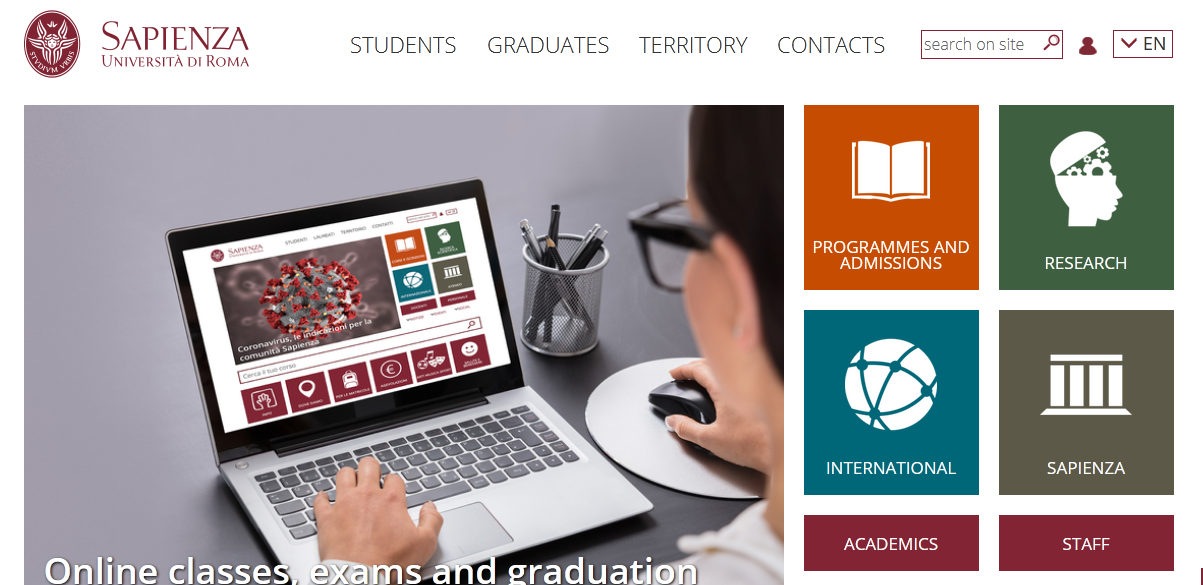
The Sapienza University of Rome, originally named Studium Urbis, was founded in 1303 by Pope Boniface VIII, making it Rome’s oldest university. Its motto ‘Il futuro è passato qui’ translates as ‘the future was here.’
After relocating to a new building in 1660, the university began to be known as Sapienza because of the inscription on its main gate, which read ‘Initium Sapientiae Timor Domini’ (the beginning of wisdom is the feat of the Lord). Sapienza is situated in the very centre of Rome, within walking distance of the main rail station, Termini.
Sapienza is the largest university in Europe, supporting over 115,000 students, including 5,500 international students, and almost 4,000 academic staff. It offers 250 degree programmes and 200 specialist courses across 63 departments, with 59 libraries available for student use (the largest number of any Italian university) as well as 21 museums.
Through the Erasmus exchange programme, Sapienza is partnered with at least 400 other universities, and maintains a strong international presence.
The university’s tuition fees are relatively low compared to most European universities and its School for Advanced Studies extends training in specific courses every year to gifted high school students alongside free accommodation and tuition.
Sapienza also offers subsidised tuition fees for students from developing countries and provides financial support for enterprises designed to improve academic and student movement to and from developing countries. Projects already funded are located in Benin, Chad, Ethiopia, Kenya, Palestine, Tanzania and Yemen.
The university counts six Nobel Prize winners among its faculty and alumni.
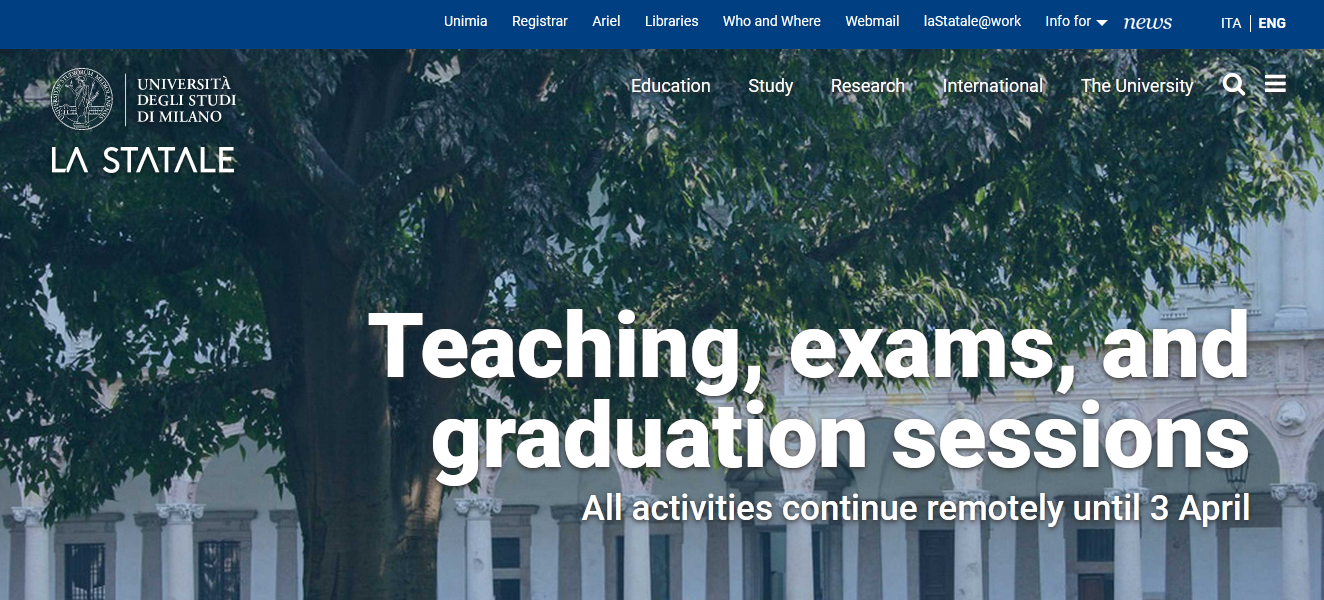
The University of Milan, founded in 1924, is a public teaching and research university with around 64,000 students.
The university’s scientific faculties are housed in Città Studi (the City of Studies), the university quarter constructed from 1915 onwards, while humanities faculties are based in buildings in the historic city centre.
The university’s artistic and cultural heritage includes botanical gardens and the former Brera Observatory building commissioned by the Holy Roman Empress Maria Theresa in the 18th Century.
Among the other historic buildings housing the university are the 15th-century Ca’ Granda in the heart of the city centre, and the 18th-century Palazzo Greppi, designed by the architect who built the city’s Scala Theatre, Giuseppe Piermarini.
The university’s collection of books is housed in 47 libraries, while rare and valuable books are collected at the APICE Centre.
The cultural life of the university and city are augmented by the institution’s choir and orchestra, which are internationally recognised.
The institution was established by the merger of the Accademia Scientifico-Letteraria (Scientific-Literary Academy), founded in 1861, and the Istituti Clinici di Perfezionamento (Clinical Specialisation Institutes), founded in 1906.
By 1928, the University of Milan already had the fourth-highest number of students of any university in Italy.
Expansion in the 1960s saw two new faculties created, while student numbers increased to 90,000 by the early 1990s.
In 1998, the institution split in two and Milan’s second public institution, the University of Milan-Bicocca, was founded.
The University of Milan now has eight faculties and two schools, offering 138 study programmes. There are also 31 doctoral schools.
The institution was one of the founder members of the League of European Research Universities and remains its only Italian member.
Polytechnic University of Milan

Established in 1863, the Polytechnic University of Milan is the largest technical university in Italy and the oldest in Milan. It specialises in design and architecture, and has also established an positive reputation for its proficiency in engineering.
Amongst elegant Italian surroundings, students have easy access to the fashion and artistic metropolis of Milan – a crux of creativity to inspire their designs. Bathed in glorious sunshine for the majority of the year, the city is home to an astounding cathedral, an extensive cultural milieu and world-class cuisine. It has a vast transport network – including three international airports – and, despite its urban setting, Milan has many regional parks.
The university’s seven campuses are spread across northern Italy: the main two in Milan, with the other five in the Lombardy and Emilia Romagna regions. It has four Schools: Architecture, Urban Planning, Construction and Engineering (on the Milano Bovisa, Milano Leonardo, Lecco, Mantova and Piacenza campuses); Design (Milano Bovisa); Civil, Environmental and Land Management Engineering (Milano Leonardo, Como and Lecco); and Industrial and Information Engineering (Milano Bovisa, Milano Leonardo, Como, Cremona, Lecco and Piacenza). The Schools are geared towards education while the 12 Departments are focused on research. The majority of its undergraduate or ‘Laurea’ courses are three years long, with part of the third year spent on work experience.
Over 100 different nationalities study at the university and it offers programmes taught through English. Among its most famous alumni are fashion designer Gianfranco Ferré; architect Giò Ponti; and chemist Giulio Natta, who studied chemical engineering there and was awarded the Nobel Prize in Chemistry in 1963.
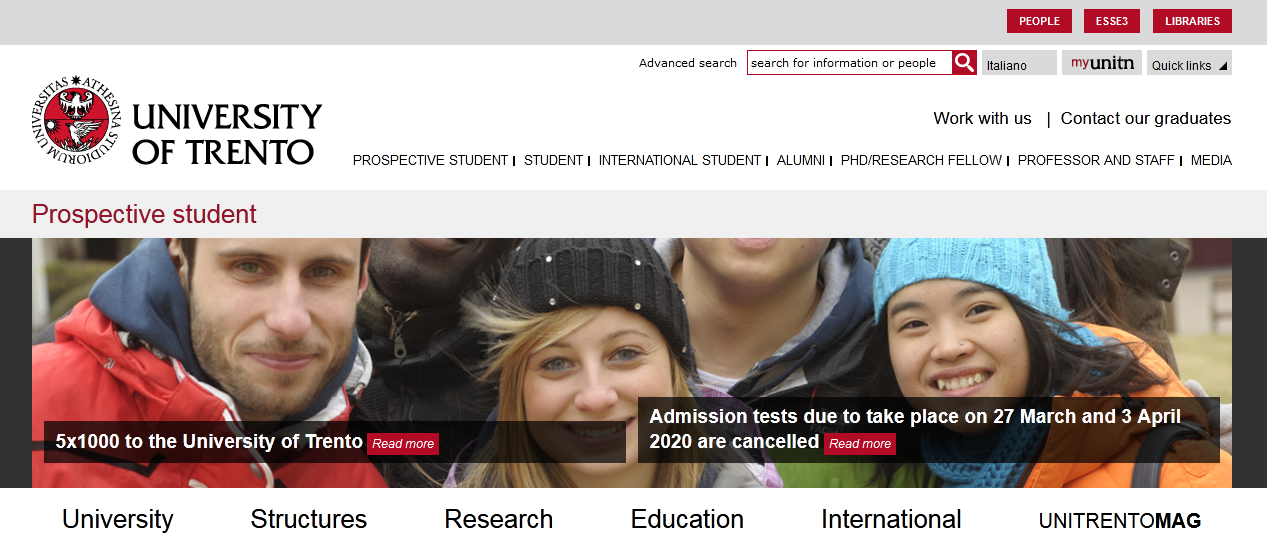
The University of Trento was first founded in 1962.
The University of Trento was founded in 1962 as an institute for social sciences. It was a pioneering institution which housed Italy’s first Faculty of Sociology. Over the following decades Trento expanded into the sciences and other subjects. It has around 16,000 students, 25 undergraduate degree options, 30 master’s programmes and 600 professors.
Today the university has ten departments and several other research and learning centres. The academic departments are Economics and Management, Law, Physics, Civil, Environmental and Mechanical Engineering, Information Engineering and Computer Science, Industrial Engineering, Humanities, Mathematics, Psychology and Cognitive Science and Sociology and Social Research.
Students can get around by borrowing a bike through the university’s Prestabici scheme.
The city of Trento, capital of Trentino, is located in northern Italy in the Adige River Valley. It lies at the heart of the Italian Alps, with a rich setting of Roman, Gothic and Renaissance architecture. Trento is reputed for offering a high quality of life to its citizens. Austria and Switzerland are both within easy reach, and their cultures have influenced Trento, making it an exciting and unique place to study in Italy.
Trento has been called a “Silicon Valley in the Alps” thanks to its growing tech industry. In recent years, entrepreneurs in have been setting up their IT, tourism and green energy businesses in the Trento valley.
University of Florence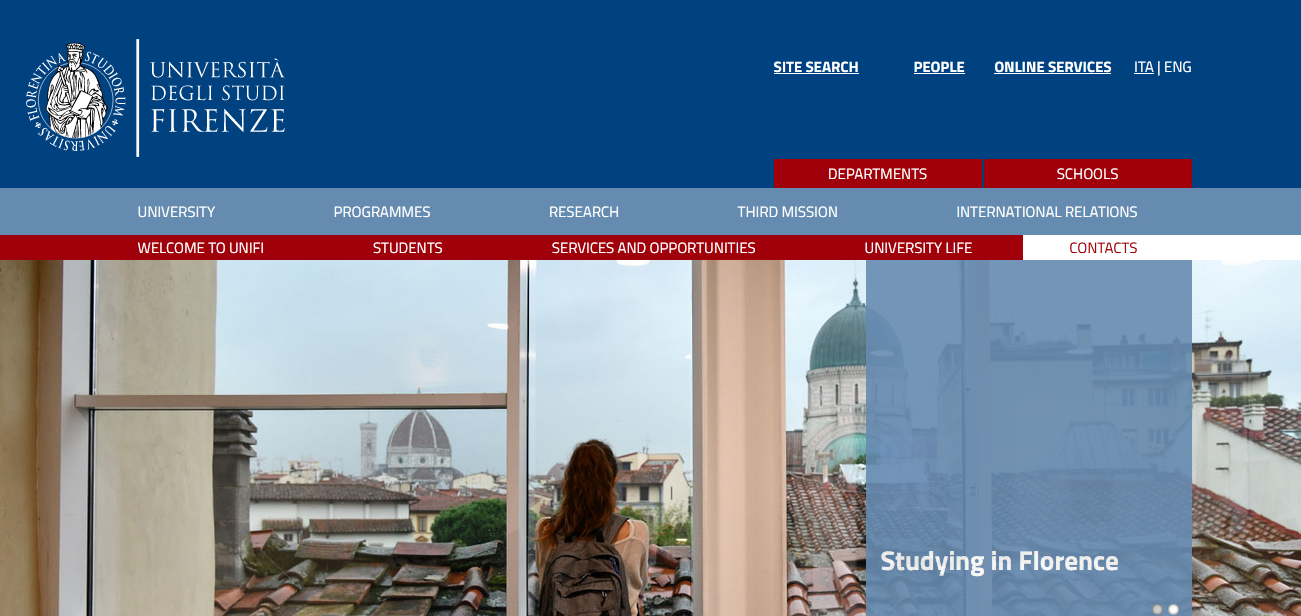
The University of Florence trace its origins to the Studium Generale, which was established by the Florentine Republic in 1321. Initially students were taught civil and canon law, literature and medicine. The importance of the Studium was fully recognised with a Bull by Pope Clemente VI in 1349. In 1924, with a special Act of Parliament the Istituto was officially made a university and was organised into faculties: Agriculture, Architecture, Arts, Economics, Education, Law, Mathematics Physical and Natural Sciences, Medicine and Surgey, Pharmacy and Political Science. The Faculty of Engineering was created in 1928 while the Faculty of Psychology was established in 2002. The new administrative structure, implemented in 2013, has transformed the Faculty into departments.
Follow us on Facebook, Twitter, Linkedin.








